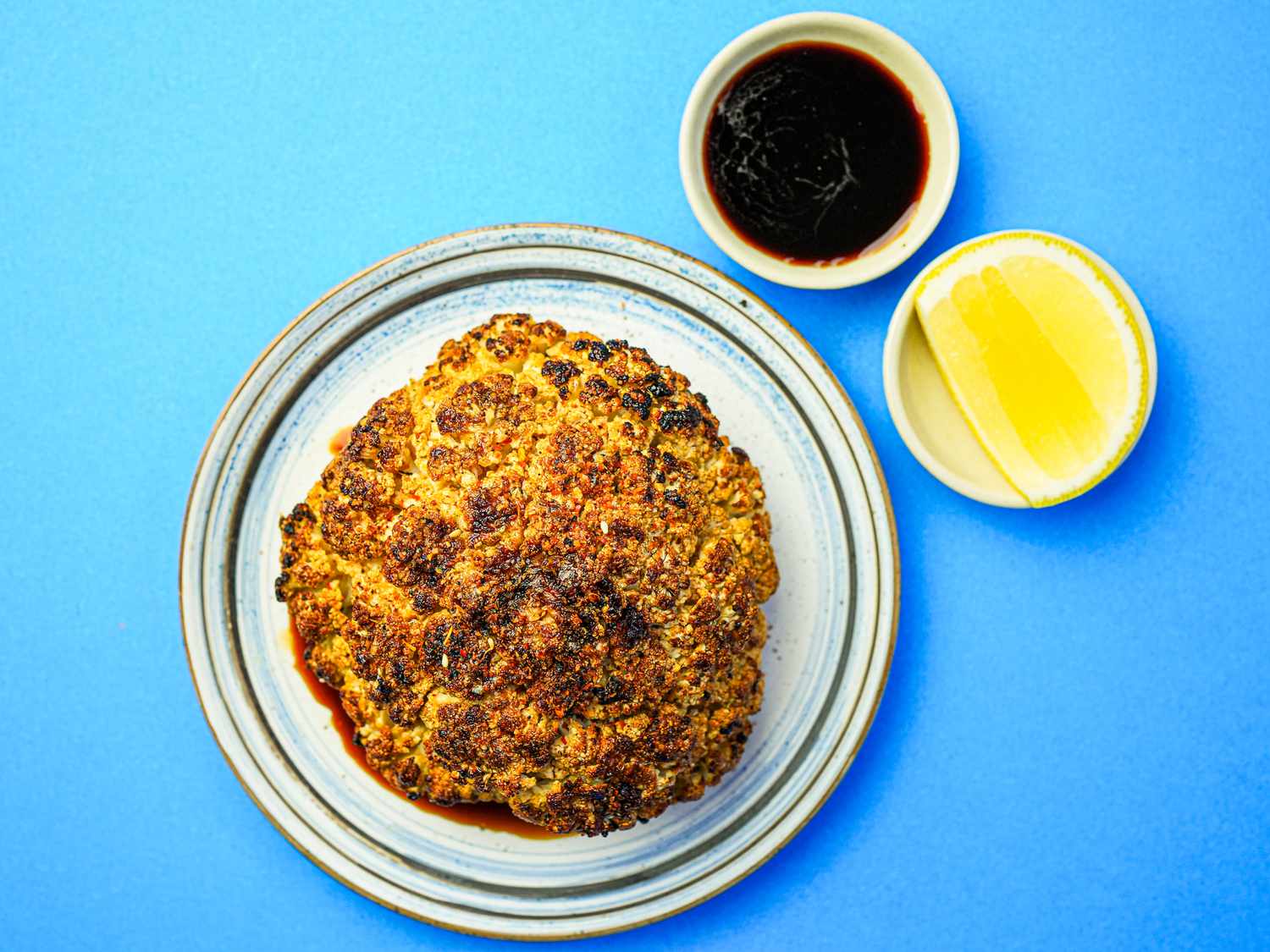
Why It Works
- Brining entire heads of cauliflower in salted water ensures deep seasoning all through.
- Beginning the cauliflower on low warmth in a lined grill earlier than shifting it to the recent aspect of the grill permits the cauliflower to turn into tender on the surface with out burning on the surface.
- Brushing the teriyaki glaze over your complete cauliflower head in levels produces a burnished, calmly charred look.
I’m a sucker for Japanese-American classics like teriyaki hen, and for me, the perfect a part of that dish isn’t the hen itself, however the smoky, chargrilled greens that always accompany it. However while you convey the teriyaki remedy to an entire head of cauliflower, it captures the spirit and what I really like most concerning the authentic: Deep umami notes, charcoal, caramelized flavors, sweetness, salt, substance. In actual fact, that is in all probability the meatiest model of cauliflower I may dream up—one thing main-course worthy.
Burnished, calmly charred domed cauliflower heads slathered in a savory teriyaki sauce has entrée power and present stopping enchantment, however correctly grilling entire heads of brassicas presents us with two frequent pitfalls: They’re typically inconsistently cooked (too crunchy on the within whereas blackened and bitter on the surface) and underneath seasoned all through. Right here’s the best way to clear up these two primary issues.
Severe Eats / Lorena Masso
3 Ideas for Grilling Complete Cauliflower Heads
1. Brine for even seasoning. One strategy to assure even seasoning—even to the woody core—is to make use of a brine. When cauliflower is submerged in a saline answer over the course of some hours, the brassica takes on an increasing number of seasoning. In earlier testing on how and why you should brine your vegetables, I discovered the distinction in taste between floor seasoning and brining for cooked cruciferous greens is stark. Right here, a soak in a 4 to five% salt brine for about three hours produces optimum outcomes, however you’ll be able to let the cauliflower sit for as much as six hours to work along with your cooking schedule.
2. Begin low and sluggish over a two-zone grill. In my first checks, after brining I merely threw the heads on the most popular aspect of the grill, however this resulted in a burnt exterior with a crunchy, undercooked middle. It was clear that I wanted to hurry up the cooking of the cauliflower’s fibrous core earlier than the outside florets overcooked. I attempted varied strategies for par-cooking the cauliflower earlier than ending it on the grill—boiling, microwaving, even baking to make sure the cauliflower heads had been cooked by way of previous to a remaining blast of warmth from the grill. Boiling and microwaving resulted in a candy inside, however for the reason that heads had been so saturated with moisture, the speed of browning was much less within the remaining stage of cooking on the grill; the feel was too tender, the cauliflower lacked depth of taste, and it additionally didn’t char as properly on the grill.
Baking was a greater path, for the reason that dry cooking surroundings drew moisture from the outside, guaranteeing that the heads charred properly on the grill. However just like my checks with boiling and microwaving, even after grilling, the baked cauliflower lacked the smoky, grilled aroma and taste I needed.
In the long run, I opted to prepare dinner the cauliflower on the grill for your complete time, and handled it just like an enormous barbecued chunk of meat, comparable to brisket or pork butt. Utilizing a two-zone oblique warmth grill set-up as described in our guide to grilling, I cooked the heads low and sluggish over the cooler aspect of the grill so there was no direct warmth beneath them, which stored the cauliflower from charring too early and turning bitter. Over 40 to 50 minutes, the inside cooked to an ideal crisp-tender texture, and took on loads of the smoky, grilled taste I used to be in search of.
3. Create layers of taste. One of many hallmarks of teriyaki is the attribute smoky taste that comes when the teriyaki sauce (and fats, if you happen to’re grilling meat) hits the coals and caramelizes, and the ensuing cloud of risky compounds floats again as much as the meals. That cascade of flavors from the response of burnt sugars and different sulfur-containing amino acids comparable to cysteine amplifies meaty taste, and it’s an enormous cause why teriyaki is particular. To imitate that, I brush the glaze on in three levels—as soon as after the primary 20 minutes of cooking and twice towards the tip of cooking when the crown of the cauliflower head will get a remaining blast of direct warmth on the grill. This manner, the cauliflower reaps the advantages from the slower Maillard reaction and caramelization taking place in the course of the longer preliminary cooking course of over the oblique warmth, but additionally develops the extra aggressive, charred flavors within the remaining hotter grilling stage on the recent aspect of the grill. The result’s burnished, smoky cauliflower that slices simply into thick wedges for serving. All it wants is a squeeze of lemon, and perhaps a bowl of rice to scarf all of it down.
Trending Merchandise










